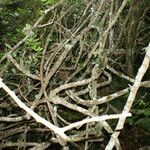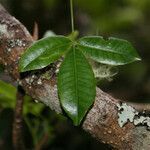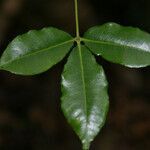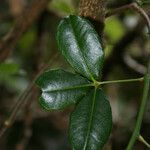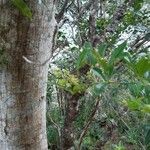A scrambling or climbing, retrorsely aculeolate shrub; young branches minutely rusty pubescent or glabrescent.. Leaflets sessile, elliptic or obovate or oblanceolate, 3–8 cm. long, 1.3–3 cm. wide, acuminate or obtuse at the apex, entire or slightly crenulate; midrib prominent and occasionally aculeolate on the lower surface; lateral nerves numerous but not raised; conspicuously glandular on both surfaces; petiole 1–4 cm. long, grooved above and persistently pubescent in the groove, sometimes aculeolate.. Inflorescence ferruginous-pubescent; bracts linear, 0.8–1.3 mm. long, caducous.. Flowers usually in cymose clusters on the panicle branches, unisexual by abortion; pedicels 1–3 mm. long.. Calyx small, with 5 acute lobes.. Petals triangular-lanceolate, ± 2.5 mm. long, yellow.. Male flowers with ovate anthers 1 mm. long; rudimentary ovary glabrous, with a long 5-ribbed style.. Female flowers with a very short style and 3–5-lobed stigma; 5 staminodes present.. Fruit 7–10 mm. across, orange when ripe.. Seeds 3–4 mm. long, dark brown, smooth.. Fig 1.
Shrubs (usually sprawling) or woody climbers, usually armed. Petiole 1-4 cm; leaflet blades usually sessile or subsessile, elliptic or narrowly elliptic to obovate to oblanceolate, 3-10 × 1-4 cm, base narrowly cuneate to attenuate, apex acuminate or rarely acute to obtuse or rounded. Inflorescences to 17 cm. Sepals 0.3-0.5 mm. Petals cream-white, ovate to elliptic, 1-3.5 mm. Stamens in male flowers 3-4 mm, in female flowers ligulate and 0.2-0.8 mm. Disk 0.2-0.5 mm. Gynoecium in female flowers ovoid to ellipsoid and 1.5-2.5 mm, in male flowers subcylindric and 1-2 mm. Fruit 5-10 mm in diam. Seeds 5-6.5 mm. Fl. year-round but mostly in spring and summer, fr. autumn and winter.
A spiny and woody vine. It is a shrub that grows 2-20 m long. The prickles are curved. The leaves are alternate and have 3 leaflets. The leaflets are pointed at both ends. The leaf stalk is 2 cm long. The leaflets are 3-10 cm long by 1-2.5 cm wide. The flowers are small, greenish and borne in large compound flower arrangements. This is 7.5 cm long. Male and female flowers are separate. The fruit are small and borne in fairly large clusters. They can be 3 to 5 angled. The fruit are 5-7 mm across. There are up to 7 seeds.
Leaves with petiole 1–4 cm. long, grooved above and persistently pubescent in the groove, sometimes aculeolate; leaflets sessile; lamina 3–7 (8) × 1·2–3 cm., elliptic or obovate or oblanceolate, that of the lateral leaflets asymmetric, chartaceous, conspicuously glandular on both surfaces, apex shortly acuminate or obtuse, margin entire or slightly crenulate; midrib prominent on the lower surface and occasionally aculeolate; lateral nerves and veins numerous, not raised.
Climber or scrambler. Branches with small recurved prickles. Leaves 3-foliolate, petiole grooved above, leaflets with midribs prominent on lower surface and occasionally aculeolate. Flowers yellow.
Flowers 5-merous, unisexual by abortion, usually in cymose clusters on the panicle-branches; pedicels 1–3 mm. long, acute, caducous.
Inflorescence shorter or as long as the subtending leaf, ferruginous-pubescent; bracts 0·8–1·3 mm. long, linear, caducous.
Sarmentose or climbing shrubs, retrorsely aculeolate; young branches and leaves ferruginous-pubescent, glabrescent.
Male flowers: stamens as long as the petals; anthers 1 mm. long, 2-lobed, ovate.
Seeds 4 mm. long, reniform; testa dark brown, hard, smooth; endosperm fleshy.
Fruit 7–8 mm. in diam., drupaceous, 3–5 (7)-locular.
Petals 2·5 mm. long, valvate.
Female flowers not seen.
